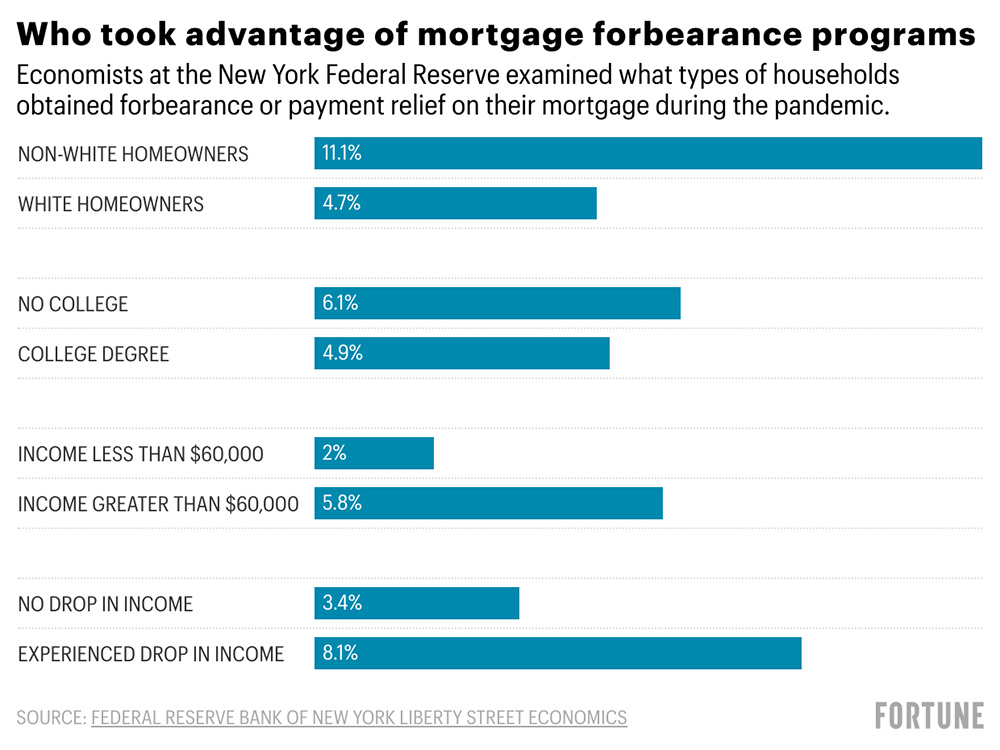去年夏天,“房贷延期支付计划”(Mortgage forbearance program)实施时,最高有超400万美国人申请延期偿还房贷。目前,参与该紧急援助项目的房主仍有约174万人。
该计划属于《关怀法案》,是美国联邦政府推出的延期偿付规定,且主要面对因新冠危机遭遇困难的借款人,只要是从政府支持的房贷机构贷款,就可享受延期还贷,最长可延期360天。除了帮助房利美和房地美等联邦机构的借款人,美国也鼓励其他贷款机构为房主提供避免违约的解决方案。
但如今回望,类似项目最大的受益者是谁?纽约联邦储备银行的经济学家分析了2020年8月《消费者预期调查》的数据发现,相比年收入低于6万美元的家庭,高收入家庭实际上受益更多。

当经济学家询问借款人,疫情期间是否获得过房贷延期或还款减免时,约5.5%的受访家庭给出了肯定答案。如果按收入细分,在年收入超过6万美元的高收入受访家庭中,约有5.8%表示获得了房贷宽限,而收入低于6万美元的家庭中仅有2%。
这一趋势与租金、信用卡和汽车贷款援助项目不同,因为这些项目中低收入的美国人获得帮助的可能性更大。
不过,虽然高收入家庭从房贷延期支付计划中获益更多,租金、信用卡和汽车贷款计划更加普遍。调查数据显示,约9.8%的租房者、11%的信用卡用户和13.6%的汽车贷款借款人获得了某种形式的还款减免。
研究人员发现,从类似救助项目中获益最多的通常是经历了失业或收入下降的家庭,与大多数项目的目标一致。
当然,随着救济项目结束,仍在依靠救济项目的美国人要如何度过难关还有待观察。比如,暂停驱逐令于2021年7月31日到期后,目前估计有1100万租房者有可能被迫搬离。
与此同时,很多房主要面临的现实是,多项联邦房贷延期支付计划将在今秋结束。6月美国消费者金融保护局为陷入困境的房主敲定了新保护措施,但拒绝全面禁止房屋止赎。(财富中文网)
译者:梁宇
审校:夏林
去年夏天,“房贷延期支付计划”(Mortgage forbearance program)实施时,最高有超400万美国人申请延期偿还房贷。目前,参与该紧急援助项目的房主仍有约174万人。
该计划属于《关怀法案》,是美国联邦政府推出的延期偿付规定,且主要面对因新冠危机遭遇困难的借款人,只要是从政府支持的房贷机构贷款,就可享受延期还贷,最长可延期360天。除了帮助房利美和房地美等联邦机构的借款人,美国也鼓励其他贷款机构为房主提供避免违约的解决方案。
但如今回望,类似项目最大的受益者是谁?纽约联邦储备银行的经济学家分析了2020年8月《消费者预期调查》的数据发现,相比年收入低于6万美元的家庭,高收入家庭实际上受益更多。
谁从房贷延期支付计划当中得利。纽约联邦储备银行的经济学家对疫情期间获得房贷延期或还款减免的家庭进行了研究。资料来源: 纽约联邦储备银行自有经济博客
当经济学家询问借款人,疫情期间是否获得过房贷延期或还款减免时,约5.5%的受访家庭给出了肯定答案。如果按收入细分,在年收入超过6万美元的高收入受访家庭中,约有5.8%表示获得了房贷宽限,而收入低于6万美元的家庭中仅有2%。
这一趋势与租金、信用卡和汽车贷款援助项目不同,因为这些项目中低收入的美国人获得帮助的可能性更大。
不过,虽然高收入家庭从房贷延期支付计划中获益更多,租金、信用卡和汽车贷款计划更加普遍。调查数据显示,约9.8%的租房者、11%的信用卡用户和13.6%的汽车贷款借款人获得了某种形式的还款减免。
研究人员发现,从类似救助项目中获益最多的通常是经历了失业或收入下降的家庭,与大多数项目的目标一致。
当然,随着救济项目结束,仍在依靠救济项目的美国人要如何度过难关还有待观察。比如,暂停驱逐令于2021年7月31日到期后,目前估计有1100万租房者有可能被迫搬离。
与此同时,很多房主要面临的现实是,多项联邦房贷延期支付计划将在今秋结束。6月美国消费者金融保护局为陷入困境的房主敲定了新保护措施,但拒绝全面禁止房屋止赎。(财富中文网)
译者:梁宇
审校:夏林
There are only about 1.74 million homeowners left in mortgage forbearance plans these days, down from the highs of over 4 million Americans in these emergency relief programs last summer.
As part of the CARES Act, the U.S. established a foreclosure moratorium and made borrowers with federally backed mortgages who experienced COVID-19-related hardships eligible for forbearance programs that would defer their monthly mortgage payments for up to 360 days. In addition to helping borrowers who used federal agencies like Fannie Mae and Freddie Mac, the U.S. encouraged other lenders to offer homeowners ways to avoid defaulting.
But looking back, who received the most help from these programs? New York Fed economists analyzed data from the August 2020 Survey of Consumer Expectations and found that higher-income households actually benefited in greater numbers from these programs than households with incomes of less than $60,000.
Economists asked borrowers if they obtained any type of forbearance or payment relief on their mortgage during the pandemic. About 5.5% of households surveyed responded that they had. When broken down by income, about 5.8% of higher income respondents (earning over $60,000) reported receiving forbearance, compared to just 2% of households earning less than $60,000.
This is a different trend than seen in rental, credit card, and auto loan assistance programs, in which lower-income Americans were more likely to take advantage of relief measures.
Yet while more higher-income households took advantage of the mortgage forbearance programs, rental, credit card, and auto loan programs were more popular as a whole. About 9.8% of renters, 11% of credit card users, and 13.6% of auto loan borrowers received some type of payment relief, according to the survey data analyzed.
Researchers, however, found that it was generally households that experienced job loss or decreased income who took advantage of these programs the most—in line with what most of these programs aimed to accomplish.
Of course, it remains to be seen how Americans who are still in these relief programs will fare as these programs end. The eviction moratorium, for example, was allowed to expire on July 31, 2021, meaning an estimated 11 million renters are now at risk of losing their home.
Meanwhile, many of the federal mortgage forbearance programs are set to end this fall for many homeowners. The Consumer Financial Protection Bureau issued a final rule in June that provided more protections for struggling homeowners but declined to outright ban foreclosures






